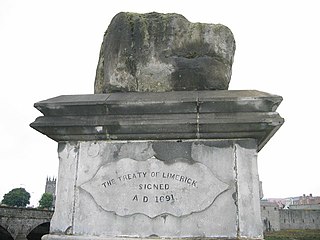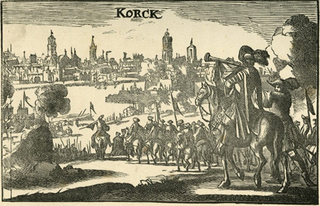
The Williamite War in Ireland took place from March 1689 to October 1691. Fought between supporters of James II and his successor, William III, it resulted in a Williamite victory. It is generally viewed as a related conflict of the 1688 to 1697 Nine Years' War.

The Battle of Aughrim was the decisive battle of the Williamite War in Ireland. It was fought between the largely Irish Jacobite army loyal to James II and the forces of William III on 12 July 1691, near the village of Aughrim, County Galway.
Robert Lundy was a Scottish army officer best known for serving as Governor of Londonderry during the early stages of the Siege of Derry.

Godard van Reede, 1st Earl of Athlone, Baron van Reede, Lord of Ginkel, born in the Netherlands as Baron Godard van Reede, was a Dutch general who rose to prominence during the Williamite War in Ireland.

Athlone was besieged twice during the Williamite War in Ireland (1689–91). The town is situated in the centre of Ireland on the River Shannon and commanded the bridge crossing the river into the Jacobite-held province of Connacht. For this reason, it was of key strategic importance.

Limerick, a city in western Ireland, was besieged twice in the Williamite War in Ireland in 1689–1691. On the first occasion, in August to September 1690, its Jacobite defenders retreated to the city after their defeat at the Battle of the Boyne. The Williamites, under William III, tried to take Limerick by storm but were driven off and had to retire into their winter quarters.

The siege of Limerick in western Ireland was a second siege of the town during the Williamite War in Ireland (1689–1691). The city, held by Jacobite forces, was able to beat off a Williamite assault in 1690. However, after a second siege in August–October 1691, it surrendered on favourable terms.
Nicholas Purcell, 13th Baron of Loughmoe was the son of James Purcell of Loughmoe and the maternal nephew of James Butler, 1st Duke of Ormonde.
Athlone is a town on the River Shannon near the southern shore of Lough Ree in Ireland. Located on the border between County Westmeath and County Roscommon, the development of the Athlone owes much to the location of a strategic ford on the Shannon.

Ballymore is a village in County Westmeath, Ireland, on the R390 road between Athlone and Mullingar. The historic Hill of Uisneach is nearby. The village was known in medieval times as the medieval borough of Ballymore Lough Sewdy, or Loughsewdy, after the nearby lake, the site of an ancient bruighean, or hostel.
John Barrett was a colonel and head of the barony of the Cork Barrett family.

The siege of Cork took place during the Williamite war in Ireland in the year of 1690, shortly after the Battle of the Boyne when James II attempted to retake the English throne from King William III.

Colonel Richard Grace was an Irish Royalist soldier who fought for Charles I, Charles II and James II. He served in the Royalist Army in Exile during the 1650s.

The siege of Carrickfergus took place in August 1689 when a force of Williamite troops under Marshal Schomberg landed and laid siege to the Jacobite garrison of Carrickfergus in Ireland. After a week the Jacobites surrendered, and were allowed to march out with the honours of war.
The raid on Newry took place in November 1689 during the Williamite War in Ireland when a Franco-Irish force loyal to James II attacked the Williamite garrison of Newry in County Down. The raid was carried out by the French Major General Alexandre de Rainier de Droue, Marquis de Boisseleau a French officer serving with James' Irish Army. It was largely unsuccessful and the Jacobite forces withdrew having suffered casualties.

The Capture of Waterford took place in July 1690 during the Williamite War in Ireland when a force under the command of Percy Kirke captured the town of Waterford from its Jacobite Irish Army garrison. Full control of the town was not secured until Duncannon Fort across Waterford Harbour was also taken from its garrison under Michael Burke shortly afterwards. In both cases the garrisons were allowed to march out under escort to Jacobite-held Mallow in County Cork, but were denied the "honours of war" which they demanded.

William Dorrington was an English army officer. Contemporary sources often spell his surname as "Dorington", or "Dodington".

The Danish Auxiliary Corps was a corps of 7,000 Danish soldiers sent to fight with William of Orange who was at war in Ireland. Disappointed with his alliance with France's King Louis XIV, Christian V of Denmark in 1689 entered into a treaty of military assistance with King William III of England. The corps was transported to Ireland, fighting against the Jacobites, participating in the battles of the Boyne and Aughrim, as well as the sieges of Limerick, Cork, Kinsale, Athlone, and Galway. In early 1692 the corps was transported to Flanders for future service in English pay.

Thomas Maxwell was a Scottish professional soldier.















